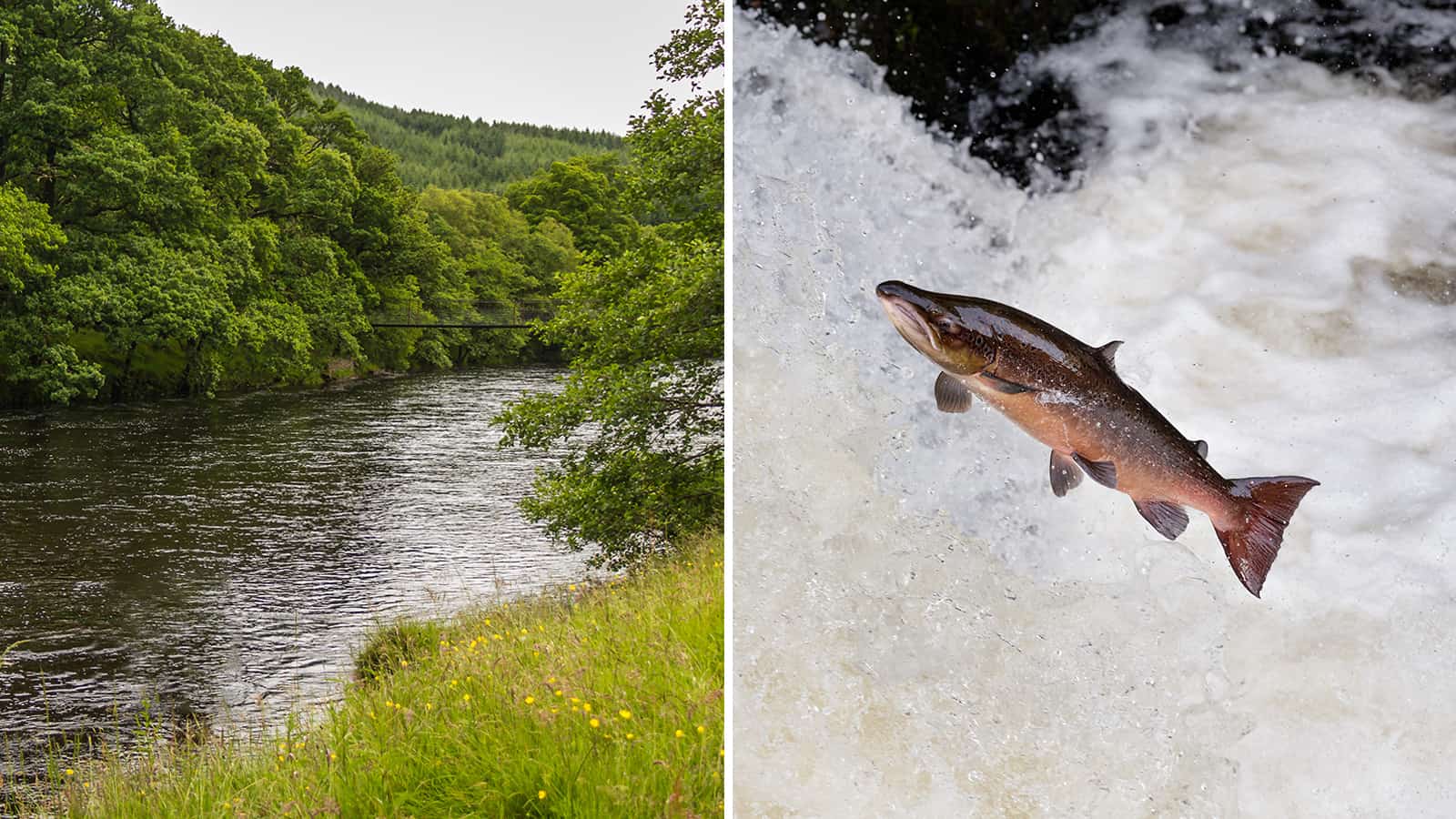Wild salmon in Scotland face increasing threats from rising water temperatures due to climate heating. In fact, fisheries scientists have found that remote rivers in Scotland have already become too warm for Atlantic salmon during summertime. In an attempt to protect them, officials have decided to plant trees along the riversides.
For instance, fisheries have planted 250,000 saplings along vital tributaries of the River Dee, one of the most popular salmon fishing rivers in the country. By 2035, they aim to plant one million trees of various species in the River Dee’s catchment. The trees planted would include native rowan, Scots pine, willow, birch, aspen, hawthorn, and juniper trees.
Wild Salmon Facing Multiple Threats in Scotland
Sadly, salmon catches along the River Dee have declined by a staggering 80% since 1957. In 2018, Scotland recorded the lowest number of catches since records began, which fueled recent conservation efforts.
That summer, climate change caused water temperatures in 70% of rivers to rise beyond safe levels on at least one day. Records showed they surpassed 23C, a dangerously high temperature that can result in stress and abnormal behavior in salmon.
Since Atlantic salmon live in cold waters, they can’t survive in summer water temperatures above 33C. While temperatures haven’t exceeded 23C yet, it’s a possibility without direct climate action.
Luckily, trees offer a natural way to shield salmon from rising temperatures. However, marine scientists discovered that only 35% of Scotland’s rivers had optimal tree cover.
Lorraine Hawkins, the river director for the Dee District Salmon Fishery Board, said that the rivers and burns in Scotland provide nurseries for young fish. When it gets too hot, it impacts their feeding and growth, which can lead to massive dieoffs.
Unfortunately, temperatures aren’t expected to cool off anytime soon. Even if we can limit temperatures to 1.5C warming or less, water temperatures will still keep rising.
Wild salmon populations also face other threats besides climate change, making it difficult for them to survive. Dams and weirs in waterways block them from traveling upstream to migrate and lay eggs.
In addition, rising seal populations endanger salmon since they feed on them. Bycatch from trawling the ocean floor along with unhealthy rivers also threatens wild salmon. Finally, parasitic sea lice can infect salmon, especially around fish farms.
Trees Provide Relief by Shading Rivers
The rivers meander through 64,000 miles of the countryside, providing habitats for salmon, birds, insects, and other marine animals. Fisheries hope that the massive tree-planting project will improve overall biodiversity and have already seen positive results. In the uplands, marine scientists have noted an increase in insect life and leaf fall.
The added trees have also helped buffer areas surrounding rivers from floods. Officials have fenced off tree nurseries in order to manage vital nutrients more efficiently. Hopefully, these conservation efforts will ensure the long-term stability of wild salmon in Scotland.
Scottish ministers have proposed ideas to conserve salmon populations but have been slow to enact change. So, fisheries decided to get the ball rolling with the tree planting project throughout the country.
It turns out that trees and salmon have a mutually beneficial relationship. The trees provide much-needed shade for salmon spawn, and the salmon offer nutrients to riverside vegetation.
When their bodies decompose, nitrogen, phosphorus, and other nutrients enter waterways and become available for vegetation. One study discovered that trees lining rivers where salmon live grow over three times faster than trees along salmon-free waterways.
Since the trees won’t take as long to mature, they will sequester carbon faster, helping us in the fight against climate change. It seems like a win-win for humans, animals and nature!
How Salmon are Adapting to Climate Change
With warming ocean, river, and stream temperatures, wild salmon have been forced to adapt quickly. They’ve evolved over millions of years to make it here, so they’re resilient animals. However, wild salmon now face immense environmental and evolutionary pressures, causing their populations to rapidly decline.
The wild salmon that do survive have adapted by doing these things:
- Migrating further north where waters aren’t as warm. Both Atlantic and Pacific wild salmon have been observed moving northward.
- Migrating from the ocean to rivers earlier in the year. Salmon DNA reveals that nature now selects for salmon migrating earlier, meaning it’s an evolutionary response to climate change.
- Remaining in cooler pools of water until ocean or river temperatures become safe enough for the salmon.
We Can Also Help Salmon Adapt
Various officials have mentioned several mitigation strategies to reduce the impacts of climate change on wild salmon. Some of these strategies include:
- Installing water temperature monitors in rivers to help locate hot spots. In Nova Scotia, officials have installed these monitors in the Margaree and Mabout Rivers, for example. If the monitors record high temperatures, work crews will plant trees along the rivers to provide shade for wild salmon.
- Diverting the flow of rivers to create larger pools of cold water. This provides shelter from extreme heat for salmon swimming upstream.
- Replacing culverts and road crossings with alternatives so that salmon can access previously blocked areas. This will expand their habitat and open up new areas for them to spawn.
- Employing fish rescue programs to provide assisted migration for salmon. In some areas of the Pacific Northwest, wild salmon are already transported past dams and weirs so they can make it upstream. Also, when stream levels dip too low, fish rescue programs assist the fish into waterways with higher flow.
Final Thoughts on Saving the Wild Salmon in Scotland
Across the globe, salmon populations face imminent threats from climate change, habitat destruction, and other human-caused factors. However, some humans have come to their rescue in order to preserve the species that cultures around the world rely on. Some strategies they’ve employed include planting trees along rivers to provide shade, diverting water in rivers to increase flow, and removing culverts to increase habitat. Hopefully, we will see a large increase in salmon populations as a result of these efforts.




















